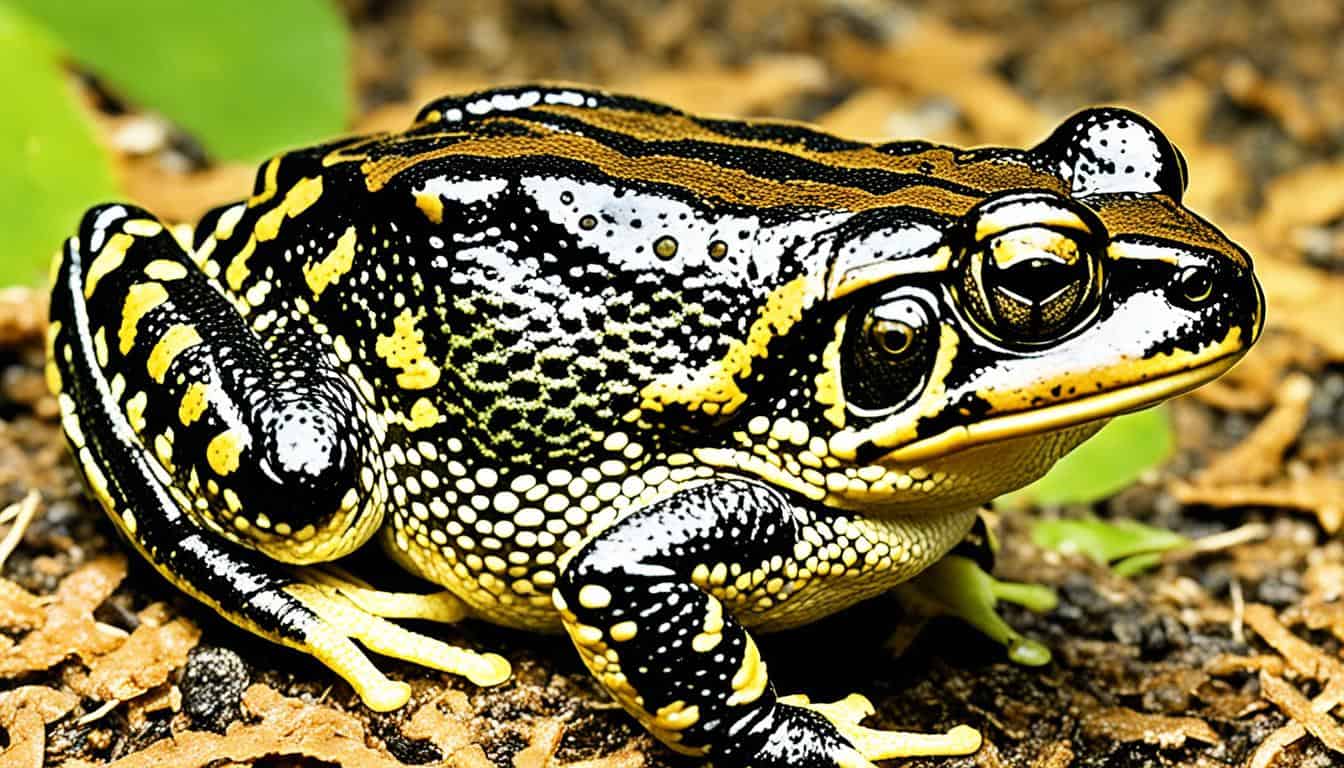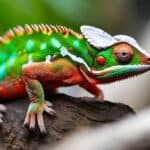Have you ever wondered how to tell the U.S. toad species apart? It’s not always easy because some toads mix and create hybrids. But you can start by looking at their skin texture, the patterns on their backs, the ridges on their skulls, and where they live. This will help you pick out some key features of each type. Still, you should know that using color or the number of warts is not always reliable.
Want to get better at spotting different U.S. toads? Then, learning the science behind their varying types may be key. Combine what you see with where you find these toads. This method can really boost your chance of figuring out what toad is what in the U.S.
Introduction to Toad Identification in the United States
Recognizing USA toads is key for many important reasons. It helps in eco research, keeps biodiversity strong, and is crucial on sites like iNaturalist. With so many types in different places, identifying them correctly is super vital.
Why Identification is Important
Knowing American toad species helps us understand our ecosystems better. This way, research and studies can be more precise. It also makes learning about nature more enjoyable, helping everyone love wildlife more.
Challenges in Toad Identification
Identifying USA toads is tough for several reasons. Mistakes are easy, especially with bad pictures or missing details. Experts like Ty Smith work hard to teach people the right way. They believe we can get better at it with good education and looking closer.
Key Physical Characteristics to Look For
Identifying toad species like the American toad needs close observation of certain traits. Looking at their skin is a good start, focusing on its texture and color patterns. These features are key in telling toad species apart.
Warty Skin vs. Smooth Skin
The feel of a toad’s skin is a big deal in identification. You’ll notice that while some have rough, warty skin, others are smoother. American toads, for example, are bumpy due to their warts. This can help tell them apart from toads with smoother skin.
Colors and Patterns
Another important part of toad ID is their colors and patterns. The top part of toads, called the dorsal side, often has distinct patterns. This includes unique spots and wart shapes on American toads. Also, looking at the general colorations helps with ID.
Understanding Geographic Distribution and Habitats
Knowing where toads live is key to figuring out which type they are in the USA. Each part of the United States has different toad types. Figuring out their specific homes helps in identifying them.
Range Maps
Range maps are great for naming USA toads accurately. They show where different toad species live. Because of this, you can see what toads are found in a specific area. For instance, you’ll learn American toads live in many places across the USA. But, Southern toads stick more to the Coastal Plains. Knowing these details makes it easier to guess which toad you might see.
Typical Habitats
Toad species like different places to live. The American toad does well in many spots, from forests to fields. It’s very adaptable. However, Fowler’s toads like sandy soils which you can find on the coasts. The Southern toads prefer soft, sandy spots, like along the coast, for digging homes. By knowing these likes, you can better figure out which toad you’re looking at.
| Species | Distribution | Typical Habitat |
|---|---|---|
| American Toad | Widespread across the United States | Forests, fields, gardens |
| Fowler’s Toad | Primarily in more localized, often coastal areas | Sandy soils, open woodlands |
| Southern Toad | Southern Coastal Plains | Loose, sandy soils, gardens |
How do you identify different species of toads in the USA?
Identifying different species of toads in the USA takes a sharp eye and knowledge of key physical features. Look closely at the spots on their backs, where warts are, and shapes of skull ridges. These can show you what type of toad you’re seeing. It’s a bit tricky because some toads are blends, showing qualities of more than one species.
Finding out what toad species you’ve come across involves a few steps:
- Dorsal Spot Patterning: Pay attention to spot size, shape, and layout on their backs. A consistent pattern can point to a certain species.
- Wart Distribution: Note where and how many warts each toad has. This can vary between species, giving you a clue.
- Cranial Ridge Shapes: Shapes of head ridges differ among toad types. They are a key toad ID feature if you can spot them.
Hybrids, which are mixes of different toad types, can complicate identification. Knowing the usual traits and the oddballs is key. Using all these methods together will make answering “How do you identify different species of toads in the USA?” easier.
American Toad (Anaxyrus americanus)
The American toad species, or Anaxyrus americanus, is easy to spot. It has round or tear-shaped spots on its back. You can also see larger warts on its back. Look for a big wart on its tibia to know it’s an American toad.
The American toad species has unique head features. Its cranial ridges form an L-shape without touching the parotid gland. There’s also a spur pointing back, making it easier to identify this toad.
| Feature | Description |
|---|---|
| Dorsal Spots | Round or tear-shaped |
| Warts on Back | Larger, prominent warts |
| Tibia Wart | At least one large wart |
| Cranial Ridges | “L”-shaped, not touching parotid gland, with a spur pointing back |
It’s key to know these characteristics for telling apart American toads from other kinds in the U.S. This knowledge can help when out in nature or using a guidebook.
Fowler’s Toad (Anaxyrus fowleri)
Fowler’s Toad is unique among toads, making it interesting for toad species identification. This is because it looks different and likes specific places to live. Knowing these key features helps to correctly spot toads in the USA.

Physical Traits
The toad stands out with its unusual markings, which are different from other types. It has lots of tiny bumps inside these marks, unlike the American Toad. You can also notice that the lines on its head sometimes go over the parotid gland. These clues are very important for telling toads apart.
Range and Habitat
Fowler’s Toads are found in many places but avoid those without sandy ground. Knowing this makes finding them easier. Their favorite living spots affect where you can see them. This is key when trying to figure out what kind of toad you see.
Southern Toad (Anaxyrus terrestris)
The Southern toad, known as Anaxyrus terrestris, stands out among American toads. This is due to its unique look and where it likes to live.
Distinctive Physical Features
Southern toads are easily recognized by the knobs on their heads. They also have “fluted” ridges between their eyes. Their back patterns come in many variations. These features help us tell Southern toads apart from other American toads.
Preferred Environments
Southern toads prefer to live in the Southern Coastal Plain. They can also be found in Southeastern Lunenburg Co. This shows how well Southern toads can live in different places within their range.
Using Cranial Ridge Patterns for Identification
Examine the cranial ridge patterns to identify USA toads better. These patterns are like fingerprints, making ID’ing toad species reliable. By looking at ridge differences, you can spot which American toad species it is.
The American toad species (Anaxyrus americanus) often has “L” shaped ridges. They usually don’t meet the parotid gland. A spur that points to the gland adds to their distinct look.
Fowler’s toad (Anaxyrus fowleri), however, has ridges across the parotid gland. This unique feature helps separate them from other toad kinds.
The Southern toad (Anaxyrus terrestris) stands out with its ridges that have knobs. These knobs are key in identifying this specific species.
Noticing these cranial ridge patterns improves toad species spotting. Below, see how these features compare:
| Toad Species | Cranial Ridge Pattern | Additional Characteristics |
|---|---|---|
| American Toad (Anaxyrus americanus) | “L” shaped ridges, not touching the parotid gland | Often a spur pointing back toward the gland |
| Fowler’s Toad (Anaxyrus fowleri) | Ridges run across the parotid gland | Irregular dorsal blotches |
| Southern Toad (Anaxyrus terrestris) | Cranial ridges with noticeable knobs | Distinct dorsal patterns |
Identifying Toad Species by Their Calls
To spot different toad types in the US, listening is key. Each type of toad has a distinct sound it makes. This makes their calls a great way to know who’s who. Although we often look for clues like warts and cranial ridges, adding sound to our observations can really help us identify them better.
When you’re in the wild, listen carefully to toad calls. The American Toad, for example, makes a long, melodious sound that can last from 4 to 30 seconds. On the other hand, the Fowler’s Toad has a shorter, more nasal call. It’s like a loud “waah” and doesn’t last for more than 5 seconds. Noting these differences in sound can help confirm which toad species live in a certain place.
For a full ID, mix seeing and hearing with knowing the environment. Listening for toad calls is especially good during their mating time. This is when males are the loudest. By sharpening your ears, you get better at knowing the many toad species in the US. This approach makes your research more complete and dependable. It also helps in saving and learning about toads.
FAQ
How do you identify different species of toads in the USA?
Identifying different toad species in the USA involves examining various physical characteristics. These include dorsal patterning, wart texture, and cranial ridge shapes. Knowing where they live and the kind of places they like can also help identify them.
Why is toad identification important?
Identifying toads accurately is key for many reasons. It helps with ecological research, keeps our ecosystems diverse, teaches new naturalists, and ensures correct data on platforms like iNaturalist.
What challenges exist in toad identification?
Identifying toads can be hard due to many reasons. Hybrids can look different from pure species. Also, toads of the same species can have varying traits. Misidentifications and bad photos make it even tougher.
What physical characteristics should you look for in toad species identification?
When trying to figure out which toad is which, check the skin for wart texture. Also, look at the patterns on their back and the size of any warts. The shape of the cranial ridges is very important too.
How do colors and patterns vary within toad species?
Toad colors and patterns vary a lot, even in the same species. It’s important to look at more than just color, like the number and size of warts. The shape of cranial ridges is a big clue as well.
How does geographic distribution aid in identifying toad species?
Where toads are found is a big clue for identification. They usually stay within their known areas. This means looking at maps can help figure out what kind of toad you’re seeing.
What are the key identification features of the American toad (Anaxyrus americanus)?
The American toad stands out with its round or tear-shaped dorsal spots and big back warts. You can usually find a large wart on its tibia. Its unique cranial ridges form an “L” shape and have a spur that doesn’t touch the parotid gland.
What physical traits are unique to Fowler’s toad (Anaxyrus fowleri)?
Fowler’s toad has a distinct look. It features irregular dorsal blotches and fewer big warts compared to the American toad. Its cranial ridges are faint and cross the top of the parotid gland.
Where is Fowler’s toad commonly found?
Fowler’s toad is common across many states but with some areas it avoids. They often choose places with sandy soil, which helps limit their habitat range.
What are the distinctive physical features of the Southern toad (Anaxyrus terrestris)?
Southern toads are unique. They have cranial knobs and cranial ridges that look “fluted.” These features are key for telling them apart. They have a variety of dorsal patterns too.
Where does the Southern toad prefer to live?
Southern toads like living in the Southern Coastal Plain, going as far as Southeastern Lunenburg Co to the west. They can be found in many types of habitats within this area.
How can cranial ridge patterns aid in toad identification?
Looking at cranial ridges is a big help in figuring out toad types. Each species has a distinct pattern. For example, in one species the ridges miss the parotid gland, while in another, they run across it.
Can toad species be identified by their calls?
Yes, toad species can be told apart by their calls. Sound is a great way to identify them. We can match the calls with other clues like how they look and where they live.







